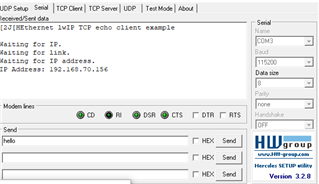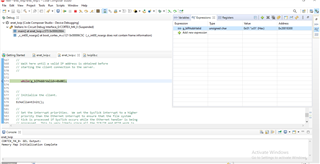Hi,
Greetings of the day!
I am new to TIVA C controller, now am working on TCP/IP echo client program, I got a document from TI here,(www.ti.com/.../spna248) I just followed the steps , server program works properly, but the problem begins with client program. In tcp_echo_client code, program get halt at this line while (g_bIPAddrValid == 0);
I just connected my board and computer with the LAN port of my office network, and I mentioned server IP address as my computers IP (i.e) #define SERVER_IPADDR "192.168.70.106" , for your reference I have attached the screenshots and the code below.
//*****************************************************************************
//
// enet_tcpecho_client_lwip.c - Sample Echo Client Application using lwIP.
//
// Copyright (c) 2019-2020 Texas Instruments Incorporated. All rights reserved.
// Software License Agreement
//
// Texas Instruments (TI) is supplying this software for use solely and
// exclusively on TI's microcontroller products. The software is owned by
// TI and/or its suppliers, and is protected under applicable copyright
// laws. You may not combine this software with "viral" open-source
// software in order to form a larger program.
//
// THIS SOFTWARE IS PROVIDED "AS IS" AND WITH ALL FAULTS.
// NO WARRANTIES, WHETHER EXPRESS, IMPLIED OR STATUTORY, INCLUDING, BUT
// NOT LIMITED TO, IMPLIED WARRANTIES OF MERCHANTABILITY AND FITNESS FOR
// A PARTICULAR PURPOSE APPLY TO THIS SOFTWARE. TI SHALL NOT, UNDER ANY
// CIRCUMSTANCES, BE LIABLE FOR SPECIAL, INCIDENTAL, OR CONSEQUENTIAL
// DAMAGES, FOR ANY REASON WHATSOEVER.
//
//
//*****************************************************************************
#include <stdbool.h>
#include <stdint.h>
#include <string.h>
#include <stdio.h>
#include "inc/hw_ints.h"
#include "inc/hw_memmap.h"
#include "inc/hw_emac.h"
#include "driverlib/flash.h"
#include "driverlib/interrupt.h"
#include "driverlib/gpio.h"
#include "driverlib/rom_map.h"
#include "driverlib/sysctl.h"
#include "driverlib/systick.h"
#include "drivers/pinout.h"
#include "utils/locator.h"
#include "utils/lwiplib.h"
#include "utils/ustdlib.h"
#include "utils/uartstdio.h"
#include "lwip/debug.h"
#include "lwip/stats.h"
#include "lwip/tcp.h"
#include "lwip/inet.h"
//*****************************************************************************
//
//! \addtogroup example_list
//! <h1>Ethernet TCP Echo Client (enet_tcpecho_client_lwip)</h1>
//!
//! This example application demonstrates the TM4C129x Ethernet Controller
//! operating as a client on the network using the lwIP TCP/IP Stack. The
//! processor will send a hello greeting message to the server after it
//! establishes a connection with the server. It will then echo back whatever
//! the server sends to it. The DHCP is used to obtain an Ethernet address.
//! If DHCP times out without obtaining an address, AutoIP will be used to
//! obtain a link-local address. The address that is selected will be shown
//! on the UART.
//!
//! UART0, connected to the Virtual Serial Port and running at 115,200, 8-N-1,
//! is used to display messages from this application.
//!
//! For additional details on lwIP, refer to the lwIP web page at:
//! http://savannah.nongnu.org/projects/lwip/
//
//*****************************************************************************
//*****************************************************************************
//
// Defines for the server IP address and PORT numbers.
//
// TODO: User must change these settings per their application.
//
//*****************************************************************************
#define SERVER_IPADDR "192.168.70.106"
#define SERVER_PORT 23
//*****************************************************************************
//
// Defines for setting up the system clock.
//
//*****************************************************************************
#define SYSTICKHZ 100
#define SYSTICKMS (1000 / SYSTICKHZ)
//*****************************************************************************
//
// Interrupt priority definitions. The top 3 bits of these values are
// significant with lower values indicating higher priority interrupts.
//
//*****************************************************************************
#define SYSTICK_INT_PRIORITY 0x80
#define ETHERNET_INT_PRIORITY 0xC0
//*****************************************************************************
//
// The variable g_ui32SysClock contains the system clock frequency in Hz.
//
//*****************************************************************************
uint32_t g_ui32SysClock;
//*****************************************************************************
//
// The current IP address.
//
//*****************************************************************************
uint32_t g_ui32IPAddress;
//*****************************************************************************
//
// Global counter to keep track the duration the connection has been idle.
//
//*****************************************************************************
uint32_t g_ui32tcpPollTick = 0;
//*****************************************************************************
//
// Volatile global flag to manage LED blinking, since it is used in interrupt
// and main application. The LED blinks at the rate of SYSTICKHZ.
//
//*****************************************************************************
volatile bool g_bLED;
//*****************************************************************************
//
// Global flag indicating when the IP address is acquired
//
//*****************************************************************************
bool g_bIPAddrValid = 0;
//*****************************************************************************
//
// Global flag indicating when the client connects to the server
//
//*****************************************************************************
bool g_bconnect = 0;
//*****************************************************************************
//
// Global LwIP PCB structure and error variables.
//
//*****************************************************************************
err_t err;
static struct tcp_pcb *tpcb;
//*****************************************************************************
//
// The error routine that is called if the driver library encounters an error.
//
//*****************************************************************************
#ifdef DEBUG
void
__error__(char *pcFilename, uint32_t ui32Line)
{
}
#endif
#define UART_DEBUG_OUT 1
//*****************************************************************************
//
// Display an lwIP type IP Address.
//
//*****************************************************************************
void
DisplayIPAddress(uint32_t ui32Addr)
{
char pcBuf[16];
// Convert the IP Address into a string.
usprintf(pcBuf, "%d.%d.%d.%d", ui32Addr & 0xff, (ui32Addr >> 8) & 0xff,
(ui32Addr >> 16) & 0xff, (ui32Addr >> 24) & 0xff);
UARTprintf(pcBuf);
}
//*****************************************************************************
//
// Required by lwIP library to support any host-related timer functions.
//
//*****************************************************************************
void
lwIPHostTimerHandler(void)
{
uint32_t ui32NewIPAddress;
//
// Get the current IP address.
//
ui32NewIPAddress = lwIPLocalIPAddrGet();
//
// See if the IP address has changed.
//
if(ui32NewIPAddress != g_ui32IPAddress)
{
//
// See if there is an IP address assigned.
//
if(ui32NewIPAddress == 0xffffffff)
{
//
// Indicate that there is no link.
//
UARTprintf("Waiting for link.\n");
}
else if(ui32NewIPAddress == 0)
{
//
// There is no IP address, so indicate that the DHCP process is
// running.
//
UARTprintf("Waiting for IP address.\n");
}
else
{
g_bIPAddrValid = 1;
//
// Display the new IP address.
//
UARTprintf("IP Address: ");
DisplayIPAddress(ui32NewIPAddress);
}
//
// Save the new IP address.
//
g_ui32IPAddress = ui32NewIPAddress;
}
//
// If there is not an IP address.
//
if((ui32NewIPAddress == 0) || (ui32NewIPAddress == 0xffffffff))
{
//
// Do nothing and keep waiting.
//
}
}
//*****************************************************************************
//
// The interrupt handler for the SysTick interrupt.
//
//*****************************************************************************
void
SysTickIntHandler(void)
{
//
// Call the lwIP timer handler.
//
lwIPTimer(SYSTICKMS);
//
// Tell the application to change the state of the LED (in other words
// blink).
//
g_bLED = true;
}
//*****************************************************************************
//
// The EchoReceive is a callback function when payload is received from the
// remote host
//
//*****************************************************************************
err_t
EchoReceive(void *arg, struct tcp_pcb *tpcb, struct pbuf *p, err_t err)
{
int len;
char *header = "Client: ";
int header_len = strlen(header);
char mydata[1024];
//
// Check for null pointer.
//
if (p == NULL)
{
//
// If null pointer has been passed in, close the connection.
//
UARTprintf("The remote host closed the connection.\n");
tcp_close(tpcb);
return ERR_ABRT;
}
else
{
tcp_recved(tpcb, p->tot_len);
#if UART_DEBUG_OUT
UARTprintf("Receive %d bytes from the remote host.\n", p->tot_len);
#endif
//
// Determine the size of the payload.
//
len = p->tot_len + header_len;
strcpy(mydata, header);
strcat(mydata, (char *)p->payload);
//
// Free the packet buffer.
//
pbuf_free(p);
//
// Check output buffer capacity.
//
if (len > tcp_sndbuf(tpcb))
len= tcp_sndbuf(tpcb);
//
// Queue the data to transmit.
//
err = tcp_write(tpcb, mydata, len, 0);
if (err == ERR_OK)
{
#if UART_DEBUG_OUT
UARTprintf("Echo the data out\n");
#endif
}
else if(err == ERR_MEM)
{
//
// We are low on memory, try later, defer to poll.
//
UARTprintf("Low on memory.\n");
}
else
{
//
// Other problems to take care of.
//
UARTprintf("Other problems.\n");
}
//
// No need for a callback when transmitting.
//
tcp_sent(tpcb, NULL);
}
return ERR_OK;
}
//*****************************************************************************
//
// Function to send TCP packets to the server
//
//*****************************************************************************
uint32_t
TcpSendPacket(char *string)
{
//
// Queues the data pointed to by string.
//
err = tcp_write(tpcb, string, strlen(string), TCP_WRITE_FLAG_COPY);
if (err)
{
UARTprintf("ERROR: Code: %d (TcpSendPacket :: tcp_write)\n", err);
return 1;
}
//
// Transmit the data.
//
err = tcp_output(tpcb);
//
// Report any error that occurs.
//
if (err)
{
UARTprintf("ERROR: Code: %d (TcpSendPacket :: tcp_output)\n", err);
return 1;
}
return 0;
}
//*****************************************************************************
//
// Callback function when the client establishes a successful connection to
// the remote host.
//
//*****************************************************************************
err_t
ConnectCallback(void *arg, struct tcp_pcb *tpcb, err_t err)
{
char *string = "Hello World! \n\r ";
if (err == ERR_OK){
#if UART_DEBUG_OUT
UARTprintf("Connection Established.\n");
#endif
g_bconnect = true;
//
// Register the callback function EchoReceive when
// receiving data
//
tcp_recv(tpcb, EchoReceive);
tcp_sent(tpcb, NULL);
#if UART_DEBUG_OUT
UARTprintf("Sending a greeting message to the Server\n");
#endif
TcpSendPacket(string);
return 0;
}
else
{
UARTprintf("No Connection Established.\n");
return 1;
}
}
//*****************************************************************************
//
// Function to create a LwIP client.
//
//*****************************************************************************
void
EchoClientInit(void)
{
//
// Create IP address structure.
//
struct ip_addr server_addr;
//
// Create a new TCP control block.
//
tpcb = tcp_new();
if (tpcb != NULL)
{
//
// Assign destination server IP address.
//
server_addr.addr = inet_addr(SERVER_IPADDR);
//
// Configure destination IP address and port.
//
err = tcp_connect(tpcb, &server_addr, SERVER_PORT, ConnectCallback);
if (err)
{
UARTprintf("ERROR: Code: %d (tcp_connect)\n", err);
}
UARTprintf("\nPCB CREATED\n");
}
else
{
memp_free(MEMP_TCP_PCB, tpcb);
UARTprintf("PCB NOT CREATED\n");
}
}
//*****************************************************************************
//
// This example demonstrates the use of the Ethernet Controller.
//
//*****************************************************************************
int
main(void)
{
uint32_t ui32User0, ui32User1;
uint8_t pui8MACArray[8];
//
// Make sure the main oscillator is enabled because this is required by
// the PHY. The system must have a 25MHz crystal attached to the OSC
// pins. The SYSCTL_MOSC_HIGHFREQ parameter is used when the crystal
// frequency is 10MHz or higher.
//
SysCtlMOSCConfigSet(SYSCTL_MOSC_HIGHFREQ);
//
// Run from the PLL at 120 MHz.
// Note: SYSCTL_CFG_VCO_240 is a new setting provided in TivaWare 2.2.x and
// later to better reflect the actual VCO speed due to SYSCTL#22.
//
g_ui32SysClock = MAP_SysCtlClockFreqSet((SYSCTL_XTAL_25MHZ |
SYSCTL_OSC_MAIN |
SYSCTL_USE_PLL |
SYSCTL_CFG_VCO_480), 120000000);
//
// Configure the device pins.
//
PinoutSet(true, false);
//
// Configure UART.
//
UARTStdioConfig(0, 115200, g_ui32SysClock);
//
// Clear the terminal and print banner.
//
UARTprintf("\033[2J\033[H");
UARTprintf("Ethernet lwIP TCP echo client example\n\n");
//
// Configure Port N1 for as an output for the animation LED.
//
MAP_GPIOPinTypeGPIOOutput(GPIO_PORTN_BASE, GPIO_PIN_1);
//
// Initialize LED to OFF (0)
//
MAP_GPIOPinWrite(GPIO_PORTN_BASE, GPIO_PIN_1, ~GPIO_PIN_1);
//
// Configure SysTick for a periodic interrupt.
//
MAP_SysTickPeriodSet(g_ui32SysClock / SYSTICKHZ);
MAP_SysTickEnable();
MAP_SysTickIntEnable();
//
// Configure the hardware MAC address for Ethernet Controller filtering of
// incoming packets. The MAC address will be stored in the non-volatile
// USER0 and USER1 registers.
//
MAP_FlashUserGet(&ui32User0, &ui32User1);
if((ui32User0 == 0xffffffff) || (ui32User1 == 0xffffffff))
{
//
// We should never get here. This is an error if the MAC address has
// not been programmed into the device. Exit the program.
// Let the user know there is no MAC address
//
UARTprintf("No MAC programmed!\n");
while(1)
{
}
}
//
// Tell the user what we are doing just now.
//
UARTprintf("Waiting for IP.\n");
//
// Convert the 24/24 split MAC address from NV ram into a 32/16 split MAC
// address needed to program the hardware registers, then program the MAC
// address into the Ethernet Controller registers.
//
pui8MACArray[0] = ((ui32User0 >> 0) & 0xff);
pui8MACArray[1] = ((ui32User0 >> 8) & 0xff);
pui8MACArray[2] = ((ui32User0 >> 16) & 0xff);
pui8MACArray[3] = ((ui32User1 >> 0) & 0xff);
pui8MACArray[4] = ((ui32User1 >> 8) & 0xff);
pui8MACArray[5] = ((ui32User1 >> 16) & 0xff);
//
// Initialize the lwIP library, using DHCP.
//
lwIPInit(g_ui32SysClock, pui8MACArray, 0, 0, 0, IPADDR_USE_DHCP);
//
// Wait here until a valid IP address is obtained before
// starting the client connection to the server.
//
while (g_bIPAddrValid == 0);
//
// Initialize the client.
//
EchoClientInit();
//
// Set the interrupt priorities. We set the SysTick interrupt to a higher
// priority than the Ethernet interrupt to ensure that the file system
// tick is processed if SysTick occurs while the Ethernet handler is being
// processed. This is very likely since all the TCP/IP and HTTP work is
// done in the context of the Ethernet interrupt.
//
MAP_IntPrioritySet(INT_EMAC0, ETHERNET_INT_PRIORITY);
MAP_IntPrioritySet(FAULT_SYSTICK, SYSTICK_INT_PRIORITY);
//
// Loop forever, processing the LED blinking. All the work is done in
// interrupt handlers.
while(1)
{
while(g_bLED == false || g_bconnect == false)
{
}
//
// Clear the flag.
//
g_bLED = false;
//
// Toggle the LED.
//
MAP_GPIOPinWrite(GPIO_PORTN_BASE, GPIO_PIN_1,
(MAP_GPIOPinRead(GPIO_PORTN_BASE, GPIO_PIN_1) ^
GPIO_PIN_1));
}
}



Thanks & regards,
Aravinth K


